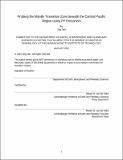Probing the Mantle Transition Zone beneath the Central Pacific Region Using PP Precursors
Author(s)
Jian, Jing
DownloadThesis PDF (1.257Mb)
Advisor
van der Hilst, Robert D.
Terms of use
Metadata
Show full item recordAbstract
The mantle transition zone (MTZ) of the Earth is bounded by globally observed discontinuities at depths of about 410 and 660 km, which are mainly attributed to the spinel and post-spinel phase transitions of olivine. The temperature-pressure relationships of phase transitions at the discontinuities, resulting in changes in seismic properties, make the MTZ a robust indicator of the mantle’s thermal and chemical conditions. With the hypothesis of an existing mantle plume under the Hawaii-Emperor seamount chain, some studies have analyzed SS precursors, underside S-wave reflections at the deep discontinuities, to constrain the thermal and compositional heterogeneities of the mantle beneath the Central Pacific. However, the analysis of PP precursors (P-wave counterparts of SS precursors) in this area and elsewhere is scarce. In this study, we compare the field observations of PP precursors and the results from thermodynamic modelings at various thermal and compositional conditions to estimate the average adiabatic mantle temperature and thickness of the MTZ beneath the Central Pacific based on the best matches of both travel times and amplitude ratios of PP precursors. We image the mantle transition zone beneath the Central Pacific using ~155,000 broadband PP waveforms and generate synthetic waveforms from thermodynamic modelings based on velocity-density profiles that represent harzburgitic (80% olivine), mixed (64% olivine) and pyrolitic (60% olivine) models at temperatures of 1,200-1,600 ºC. With the curvelet transform, an array processing technique, we improve the signal-to-noise ratio of PP precursors by suppressing the energy from interfering phases for images from both observations and synthetic waveforms and reveal the precursors over a more extensive epicentral distance range. The observation shows strong reflections at 410- and 520-km discontinuities but a weak one at 660-km discontinuity; thus, we focus on P410 and P520P. We conduct differential time analysis by measuring the difference between the arrival times of P410P and P520P for both the observation and synthetic waveforms, and the comparisons along with pressure-temperature data from mineral physics suggest an average mantle temperature of 1,200-1,250 ºC with no differentiation among compositional types. A more promising method is used by measuring and comparing the peak amplitude ratios of precursors to the main PP between the observation and synthetic waveforms around the predicted arrivals in time. The amplitude analysis shows that the model that best resembles the observation is a combination of pyrolitic model for the upper mantle and a mixture of 80% harzburgite and 20% basalt deeper in the MTZ at 1,350-1,450 ºC, suggesting an average adiabatic mantle temperature of 1,400±50 ºC and a composition of ~60-64% olivine. We also locate the depths of the 410- and 660-km discontinuity from the velocity-density profiles and calculate the thickness of the MTZ, which is 253±3 km. We calculate the differential travel time of P410P and P520P laterally across the region and conclude that the MTZ temperature is generally lower to the west and southwest and higher to the north and east of Hawaii.
Date issued
2022-09Department
Massachusetts Institute of Technology. Department of Earth, Atmospheric, and Planetary SciencesPublisher
Massachusetts Institute of Technology